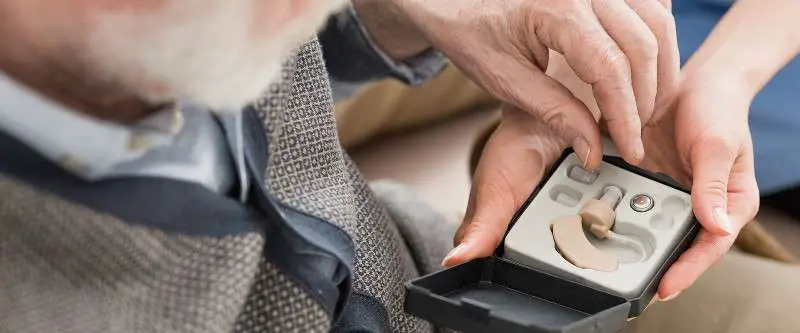Introduction
How to Care for Someone with Conductive Hearing Loss
If you are caring for someone who has been diagnosed with conductive hearing loss, you may have many questions and concerns. Conductive hearing loss is a type of hearing loss that affects the outer or middle ear, making it difficult for sounds to reach the inner ear. This can cause difficulty hearing soft or low-volume sounds, as well as other symptoms such as ear pain, pressure, or drainage.
Conductive hearing loss can have various causes, such as ear infections, earwax buildup, eardrum perforation, or abnormal growths in the ear. Some of these causes are temporary and can be treated with medication, surgery, or hearing aids. Others may be permanent and require more long-term management.
In this blog post, we will cover some of the topics that you may want to know more about when caring for someone with conductive hearing loss. We will explain what to expect during an evaluation, how to interpret an audiogram, what questions to ask your doctor, and what treatment options are available. We will also provide some tips on how to cope with the emotional and practical aspects of living with conductive hearing loss.
We hope that this blog post will help you understand more about conductive hearing loss and how to support your loved one through this journey.
Tweak Digital Hearing Amplifier
Experience the epitome of sophisticated sound with Tweak, the revolutionary device that brings a new dimension to your auditory experience. Harnessing the power of innovative patented technology, Tweak offers you the freedom to fine-tune your hearing with a diverse range of amplification options. Whether you prefer a subtle enhancement or a more pronounced boost, Tweak empowers you to effortlessly customize your acoustic world.
Crafted with meticulous care and expertise, Tweak represents the brilliant collaboration between an esteemed audiologist and a team of dedicated acoustic engineers. Their collective passion for impeccable sound quality shines through in every detail of this remarkable device. Designed to elevate your hearing capabilities across any environment, Tweak utilizes cutting-edge technology to ensure that you can fully engage with the sounds that matter most to you.
Unlock the extraordinary potential of affordable sound quality with Tweak. By leveraging the latest advancements in digital technology, this ingenious device delivers an auditory experience that rivals that of prescription hearing aids. With premium-grade components at its core, Tweak offers you uncompromising performance without breaking the bank. Immerse yourself in a world of enhanced sound, where clarity and richness seamlessly merge to create an exceptional listening experience.
Coming to Terms with a Conductive Hearing Loss Diagnosis
The first step in caring for someone with conductive hearing loss is to accept the diagnosis and understand what it means. Conductive hearing loss is not a life-threatening condition, but it can have a significant impact on the quality of life of the person affected and their caregivers.
Conductive hearing loss can affect communication, social interaction, education, work, and leisure activities. It can also cause frustration, isolation, anxiety, depression, or low self-esteem. These emotional reactions are normal and understandable, but they can be managed with proper support and guidance.
Some of the ways that you can help your loved one cope with the diagnosis of conductive hearing loss are:
• Be supportive and empathetic. Listen to their feelings and concerns without judging or minimizing them. Acknowledge their challenges and validate their emotions.
• Be informed and proactive. Learn as much as you can about conductive hearing loss and its causes, symptoms, diagnosis, treatment, and prognosis. Seek reliable sources of information such as your doctor, audiologist, or reputable websites. Avoid misinformation or myths that may cause confusion or false hopes.
• Be involved and collaborative. Accompany your loved one to their appointments and tests. Ask questions and take notes. Share your observations and opinions. Help them make informed decisions about their treatment and care plan.
• Be positive and hopeful. Focus on the strengths and abilities of your loved one rather than their limitations. Encourage them to pursue their goals and interests. Celebrate their achievements and progress. Remind them that they are not alone and that there are many resources and options available to help them.
What to Expect During an Evaluation for Conductive Hearing Loss
The next step in caring for someone with conductive hearing loss is to undergo a comprehensive evaluation by a qualified professional. This will help determine the exact cause, type, degree, and configuration of the hearing loss, as well as the best treatment options.
The evaluation may include:
• A medical history interview. The doctor or audiologist will ask about the onset, duration, severity, and fluctuation of the hearing loss; any associated symptoms such as ear pain, pressure, drainage, dizziness, or tinnitus; any previous ear infections, injuries, surgeries, or treatments; any family history of hearing loss; any exposure to loud noise or ototoxic drugs; any other medical conditions or medications; any impact on daily activities or quality of life.
• A physical examination. The doctor will inspect the outer ear canal and eardrum using an otoscope (a lighted instrument) or a video otoscope (a camera attached to an otoscope). They will look for any signs of infection, inflammation, wax buildup, foreign objects, perforation, scarring, or growths in the ear.
• A hearing test (audiometry). The audiologist will measure the hearing thresholds (the softest sounds that can be heard) at different frequencies (pitches) using headphones or speakers. They will also test the ability to understand speech in quiet and noisy environments using recorded words or sentences. The results will be plotted on a graph called an audiogram (see below).
• A tympanometry test. The audiologist will measure how well the eardrum moves in response to changes in air pressure using a probe inserted into the ear canal. This will help assess the function of the middle ear and detect any fluid buildup or stiffness behind the eardrum.
• A bone conduction test. The audiologist will measure the hearing thresholds using a vibrator placed behind the ear or on the forehead. This will bypass the outer and middle ear and stimulate the inner ear directly. This will help differentiate between conductive and sensorineural hearing loss.
• Other tests. Depending on the suspected cause of the hearing loss, the doctor or audiologist may order additional tests such as blood tests, imaging tests (such as X-rays, CT scans, or MRI scans), or genetic tests.
The evaluation may take one or more visits and may last from 30 minutes to several hours. It is important to follow the instructions given by the doctor or audiologist before, during, and after the evaluation. For example, you may be asked to avoid any loud noise or earwax removal for a few days before the test, to bring any hearing aids or devices that you use, to answer the questions honestly and clearly, and to report any changes or concerns after the test.
NAVIGATING THE DIFFERENT LEVELS OF DEAFNESS
Interpreting Your Audiogram: A Guide for Conductive Hearing Loss Patients
One of the most important outcomes of the evaluation for conductive hearing loss is the audiogram. The audiogram is a graph that shows the hearing thresholds at different frequencies for each ear. It can help you and your doctor or audiologist understand the type, degree, and configuration of your hearing loss, as well as the potential treatment options.
Here is how to read your audiogram:
• The horizontal axis (X-axis) represents the frequency or pitch of the sound, measured in hertz (Hz). The lower frequencies are on the left and the higher frequencies are on the right. The normal range of human hearing is from 20 Hz to 20,000 Hz, but most speech sounds are between 250 Hz and 8,000 Hz.
• The vertical axis (Y-axis) represents the intensity or loudness of the sound, measured in decibels (dB). The lower intensities are on the top and the higher intensities are on the bottom. The normal range of human hearing is from 0 dB to 120 dB, but most speech sounds are between 20 dB and 60 dB.
• The symbols on the graph represent the hearing thresholds for each ear. The circles (O) represent the right ear and the crosses (X) represent the left ear. The symbols are connected by lines to show the pattern of hearing loss. The air conduction thresholds show how well you hear sounds through headphones or speakers. The bone conduction thresholds show how well you hear sounds through a vibrator behind the ear or on the forehead.
• The degree of hearing loss is determined by comparing the hearing thresholds to the normal range of hearing (0 dB to 25 dB). The degree of hearing loss can be classified as mild (26 dB to 40 dB), moderate (41 dB to 55 dB), moderately severe (56 dB to 70 dB), severe (71 dB to 90 dB), or profound (91 dB or more).
• The type of hearing loss is determined by comparing the air conduction thresholds and the bone conduction thresholds. If both thresholds are similar, it means that there is a sensorineural hearing loss, which affects the inner ear or the auditory nerve. If there is a gap between the thresholds, it means that there is a conductive hearing loss, which affects the outer or middle ear. If there is a combination of both, it means that there is a mixed hearing loss, which affects both parts of the ear.
• The configuration of hearing loss is determined by looking at the shape of the hearing loss across different frequencies. The configuration can be flat (similar hearing loss across all frequencies), sloping (more hearing loss at higher frequencies), rising (more hearing loss at lower frequencies), cookie bite (less hearing loss at mid frequencies), notch (less hearing loss at one specific frequency), or corner (only residual hearing at very low frequencies).
Here is an example of an audiogram showing a conductive hearing loss in both ears:
https://www.enthealth.org/wp-content/uploads/2019/07/Conductive-Hearing-Loss-Audiogram.png
As you can see, there is a gap between the air conduction thresholds and the bone conduction thresholds, indicating a conductive hearing loss. The degree of hearing loss is moderate to moderately severe in both ears. The configuration of hearing loss is flat in both ears.
Your audiogram may look different depending on your individual condition and test results. Your doctor or audiologist will explain your audiogram to you and discuss what it means for your treatment and care.
QUIZ - CAUSES OF HEARING LOSS IN CHILDREN
Questions to Ask Your Doctor After a Conductive Hearing Loss Diagnosis
After you have received your audiogram and your diagnosis of conductive hearing loss, you may have many questions for your doctor or audiologist. It is important to ask these questions and get clear and accurate answers, as this will help you understand your condition better and make informed decisions about your treatment and care.
Some of the questions that you may want to ask your doctor or audiologist are:
• What is the cause of my conductive hearing loss? Is it temporary or permanent? Is it progressive or stable?
• How severe is my conductive hearing loss? How does it affect my ability to hear speech and other sounds? How does it affect my daily activities and quality of life?
• What are the treatment options for my conductive hearing loss? What are the benefits, risks, and costs of each option? How effective are they? How long do they last?
• Do I need any medication, surgery, or hearing aids for my conductive hearing loss? How do they work? How do I use them? How do I take care of them? What are the possible side effects or complications?
• Do I need any follow-up appointments or tests for my conductive hearing loss? How often do I need them? What do they involve?
• Do I need any referrals to other specialists or services for my conductive hearing loss? Who are they and what do they do?
• Do I need any support or counseling for my conductive hearing loss? How can I cope with the emotional and social impact of my hearing loss? How can I communicate better with others?
• Do I need any education or training for my conductive hearing loss? How can I learn more about my condition and how to manage it? Are there any books, websites, or organizations that can help me?
• Do I need any accommodations or modifications for my conductive hearing loss? How can I make my home, work, school, or leisure environment more accessible and comfortable for me?
• Do I need any prevention or protection for my conductive hearing loss? How can I avoid further damage or deterioration of my hearing? How can I protect my ears from noise, infection, or injury?
These are some of the common questions that you may have after a conductive hearing loss diagnosis. However, you may have other questions that are specific to your situation and needs. You should not hesitate to ask any question that you have, no matter how big or small. Your doctor or audiologist is there to help you and provide you with the best possible care.
Understanding Your Treatment Options for Conductive Hearing Loss
The treatment options for conductive hearing loss depend on the cause, type, degree, and configuration of the hearing loss, as well as the preferences and goals of the patient and the caregiver. The main goals of treatment are to restore or improve hearing, to prevent or treat any complications, and to enhance the quality of life of the patient and the caregiver.
Some of the treatment options for conductive hearing loss are:
• Medication. Some cases of conductive hearing loss can be treated with medication, such as antibiotics, antihistamines, decongestants, or steroids. These can help reduce inflammation, infection, or fluid buildup in the ear. However, medication may not be effective for all causes of conductive hearing loss, and may have side effects or interactions with other drugs.
• Surgery. Some cases of conductive hearing loss can be treated with surgery, such as tympanoplasty (repairing a hole in the eardrum), mastoidectomy (removing infected or diseased tissue from the mastoid bone behind the ear), stapedectomy (replacing a stiffened or fixed stapes bone in the middle ear with a prosthesis), or ossiculoplasty (repairing or replacing the damaged bones of the middle ear). Surgery can help restore or improve hearing by correcting the structural or functional problem in the ear. However, surgery may not be suitable for all patients, and may have risks or complications such as infection, bleeding, scarring, nerve damage, or hearing loss.
• Hearing aids. Some cases of conductive hearing loss can be treated with hearing aids, which are electronic devices that amplify sounds and deliver them to the ear. Hearing aids can help improve hearing by making sounds louder and clearer. There are different types and styles of hearing aids, such as behind-the-ear (BTE), in-the-ear (ITE), in-the-canal (ITC), or completely-in-the-canal (CIC). Hearing aids can be customized to fit the shape and size of the ear, and to match the degree and configuration of the hearing loss. However, hearing aids may not be effective for all causes of conductive hearing loss, and may have drawbacks such as cost, maintenance, feedback, occlusion, or stigma.
• Bone conduction devices. Some cases of conductive hearing loss can be treated with bone conduction devices, which are devices that bypass the outer and middle ear and stimulate the inner ear directly through vibrations. Bone conduction devices can help improve hearing by delivering sounds to the cochlea without any obstruction or interference. There are different types of bone conduction devices, such as bone-anchored hearing aids (BAHA), which are surgically implanted into the skull; bone conduction headbands or glasses, which are worn on the head or over the ears; or bone conduction implants, which are inserted under the skin behind the ear. Bone conduction devices can be an alternative to conventional hearing aids for patients who have chronic ear infections, ear canal problems, or single-sided deafness. However, bone conduction devices may not be suitable for all patients, and may have risks or complications such as infection, skin irritation, cosmetic concerns, or device failure.
• Cochlear implants. Some cases of conductive hearing loss can be treated with cochlear implants, which are devices that bypass the damaged parts of the ear and stimulate the auditory nerve directly with electrical signals. Cochlear implants can help restore hearing by converting sounds into electrical impulses that are sent to the brain. Cochlear implants consist of two parts: an external part that consists of a microphone, a processor, and a transmitter; and an internal part that consists of a receiver and an electrode array. Cochlear implants require surgery to implant the internal part into the cochlea. Cochlear implants can be a last resort option for patients who have severe to profound conductive hearing loss that cannot be treated with other methods. However, cochlear implants may not be appropriate for all patients, and may have risks or complications such as infection, bleeding, nerve damage, device malfunction, or loss of residual hearing.
These are some of the treatment options for conductive hearing loss. Your doctor or audiologist will recommend the best option for you based on your condition and needs. You should discuss the pros and cons of each option with your doctor or audiologist before making a decision.
Tinnitus: why it’s still such a mystery to science
Conclusion
Conductive hearing loss is a type of hearing loss that affects the outer or middle ear, making it difficult for sounds to reach the inner ear. It can have various causes, such as ear infections, earwax buildup, eardrum perforation, or abnormal growths in the ear. It can cause symptoms such as difficulty hearing soft or low-volume sounds, ear pain, pressure, or drainage.
Conductive hearing loss can be diagnosed by a comprehensive evaluation that includes a medical history interview, a physical examination, a hearing test, a tympanometry test, a bone conduction test, and other tests if needed. The evaluation will help determine the cause, type, degree, and configuration of the hearing loss, as well as the best treatment options.
Conductive hearing loss can be treated with medication, surgery, hearing aids, bone conduction devices, or cochlear implants, depending on the condition and preferences of the patient and the caregiver. The treatment options have different benefits, risks, and costs, and should be discussed with the doctor or audiologist before making a decision.
Conductive hearing loss can have a significant impact on the quality of life of the patient and the caregiver. It can affect communication, social interaction, education, work, and leisure activities. It can also cause emotional and psychological distress. Therefore, it is important to seek professional help and support as soon as possible.
Caring for someone with conductive hearing loss can be challenging but rewarding. It requires acceptance, understanding, involvement, positivity, and hope. It also requires education, training, support, counseling, accommodation, and prevention. By following these steps, you can help your loved one cope with conductive hearing loss and live their best life possible.
We hope that this blog post has helped you learn more about conductive hearing loss and how to care for someone who has it. If you have any questions or comments, please feel free to leave them below. Thank you for reading!

Harmonizing Life with Mixed Hearing Loss: A Global Perspective
Dive into the complexities of Mixed Hearing Loss with our comprehensive guide, exploring diagnosis, treatment options, and practical tips for daily management

Harmonizing Silence and Sound: Mastering Mixed Hearing Loss
Dive into the complexities of Mixed Hearing Loss with our comprehensive guide, exploring diagnosis, treatment options, and practical tips for daily management.






